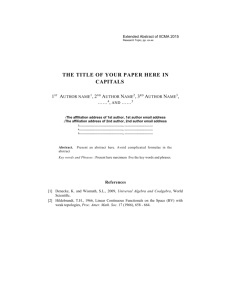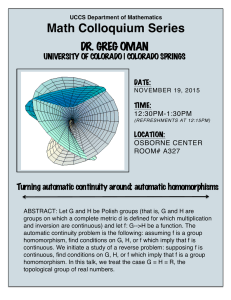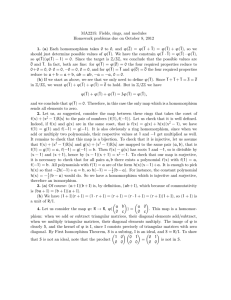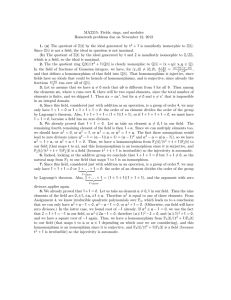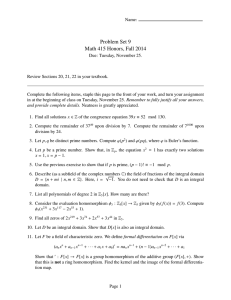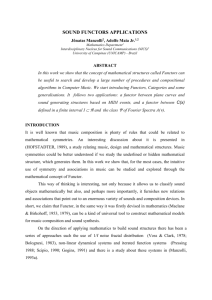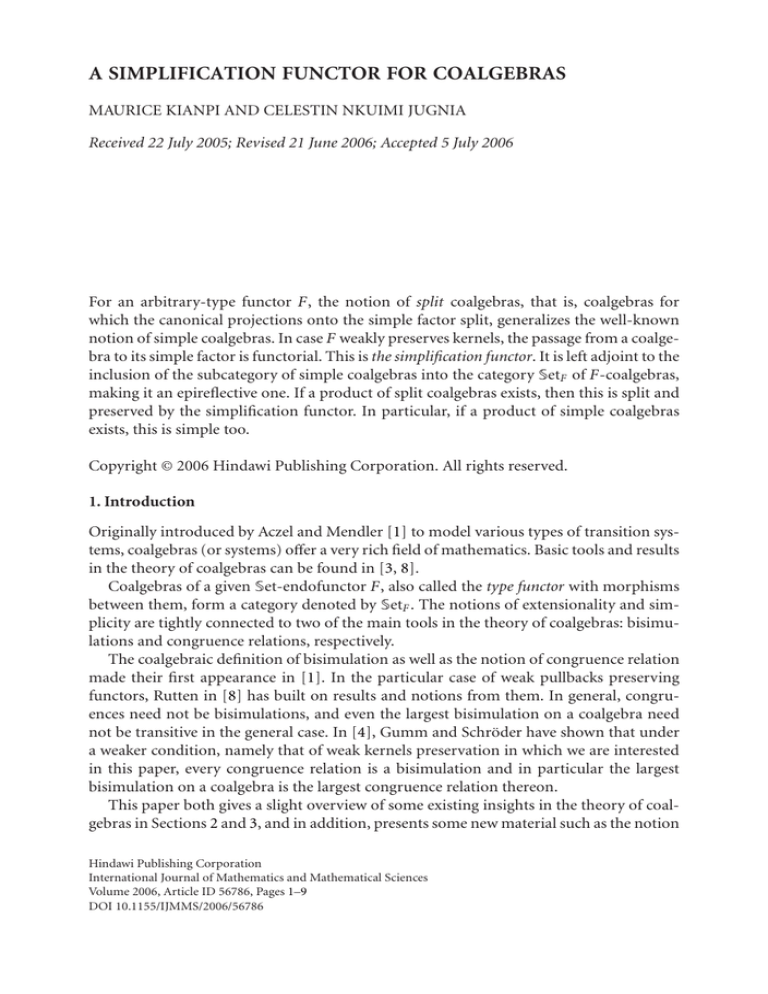
A SIMPLIFICATION FUNCTOR FOR COALGEBRAS
MAURICE KIANPI AND CELESTIN NKUIMI JUGNIA
Received 22 July 2005; Revised 21 June 2006; Accepted 5 July 2006
For an arbitrary-type functor F, the notion of split coalgebras, that is, coalgebras for
which the canonical projections onto the simple factor split, generalizes the well-known
notion of simple coalgebras. In case F weakly preserves kernels, the passage from a coalgebra to its simple factor is functorial. This is the simplification functor. It is left adjoint to the
inclusion of the subcategory of simple coalgebras into the category SetF of F-coalgebras,
making it an epireflective one. If a product of split coalgebras exists, then this is split and
preserved by the simplification functor. In particular, if a product of simple coalgebras
exists, this is simple too.
Copyright © 2006 Hindawi Publishing Corporation. All rights reserved.
1. Introduction
Originally introduced by Aczel and Mendler [1] to model various types of transition systems, coalgebras (or systems) offer a very rich field of mathematics. Basic tools and results
in the theory of coalgebras can be found in [3, 8].
Coalgebras of a given Set-endofunctor F, also called the type functor with morphisms
between them, form a category denoted by SetF . The notions of extensionality and simplicity are tightly connected to two of the main tools in the theory of coalgebras: bisimulations and congruence relations, respectively.
The coalgebraic definition of bisimulation as well as the notion of congruence relation
made their first appearance in [1]. In the particular case of weak pullbacks preserving
functors, Rutten in [8] has built on results and notions from them. In general, congruences need not be bisimulations, and even the largest bisimulation on a coalgebra need
not be transitive in the general case. In [4], Gumm and Schröder have shown that under
a weaker condition, namely that of weak kernels preservation in which we are interested
in this paper, every congruence relation is a bisimulation and in particular the largest
bisimulation on a coalgebra is the largest congruence relation thereon.
This paper both gives a slight overview of some existing insights in the theory of coalgebras in Sections 2 and 3, and in addition, presents some new material such as the notion
Hindawi Publishing Corporation
International Journal of Mathematics and Mathematical Sciences
Volume 2006, Article ID 56786, Pages 1–9
DOI 10.1155/IJMMS/2006/56786
2
A simplification functor for coalgebras
of split coalgebra introduced in Section 4. This generalizes the notion of simple coalgebras
as does [5] that of extensional coalgebra (see Section 3). The fact that the quotient of a
coalgebra with respect to a congruence relation [3] yields again a coalgebra helps to build
many coalgebras from a given one. It turns out that amidst these, the quotient with respect to the largest congruence relation is its sole factor which is simple. We call it its
simple factor (see Section 3). This uniqueness draws our attention to a study in Section 5
of the passage from an F-coalgebra to its simple factor. Fortunately, as is shown here, in
case the type functor weakly preserves kernels, this passage is functorial. We call it the
simplication functor and show that it is left adjoint to the inclusion functor of the subcategory Simp(F) of simple F-coalgebras making it an epireflective one. We also show that
if a product of split coalgebras exists, then it is split and that the simplification functor
is well-behaved with respect to split coalgebras, as far as the preservation of products is
concerned. This implies that if a product of simple coalgebras exists, then it is simple too.
2. Preliminaries
2.1. Some categorical notions
2.1.1. Epireflective subcategory. If a functor I : C → D is an inclusion, then a left adjoint
S : D → C is called a reflection. If C is a full subcategory and there exists a reflection S such
that the unit ηX : X → (I ◦ S)(X) is an epimorphism for all objects X in D, the subcategory
[9] C is called epireflective. If there exists a reflection S for a subcategory C, then (see [9])
there exists one which is the identity on C, that is, such that S ◦ I = idC . If such a reflection
is chosen, then it is called an epireflector.
2.1.2. Weak limits preservation.
Definition 2.1. Let F : C → C be a functor and D : I → C a diagram for which D-limits
exist in C. Then,
(i) F weakly preserves D-limits, if F transforms every limit cone over D into a weak
limit cone over F ◦ D, that is, for every limit (L,(vk )k∈κ ) of the diagram D, (F(L),
F(vk )k∈κ ) is a weak limit of the diagram F ◦ D;
(ii) F preserves weak D-limits if it transforms every weak limit cone over D into a weak
limit cone over F ◦ D.
It is quite clear that there is a fine linguistic difference between “F preserves weak Dlimits” and “F weakly preserves D-limits.” But fortunately, it has been proven [3, 4] that
the difference disappears in every category in which D-limits exist.
2.2. Some basic facts about coalgebras. Let F be a type functor C → C. An F-coalgebra
is just a pair (A, αA : A → F(A)) where A is an object called the carrier and αA a morphism
called the structure of the coalgebra. This will often be denoted by (A,αA ) or by the single
letter Ꮽ. A homomorphism from a coalgebra Ꮽ = (A,αA ) to a coalgebra Ꮾ = (B,αB ) is a
map f : A → B such that F( f ) ◦ αA = αB ◦ f .
F-coalgebras with their homomorphisms form a category CF which is cocomplete provided that C is cocomplete. More precisely, the forgetful functor U : CF → C which associates to each F-coalgebra Ꮽ its underlying object A creates colimits. This can be found
M. Kianpi and C. N. Jugnia 3
in [2] in the setting of category Set which serves as the basic category from now on. As
for limits, the forgetful functor [7] creates those which are preserved by the functor F.
Epis in SetF are just surjective homomorphisms and every injective homomorphism is a
mono [8].
2.2.1. Generation of homomorphisms. The following theorem can be used to prove that a
map is a homomorphism.
Theorem 2.2 [7]. Let Ꮽ, Ꮾ, and Ꮿ be coalgebras, ϕ : Ꮽ → Ꮿ a homomorphism, f : A → B
and g : B → C maps with ϕ = g ◦ f .
(1) If f is a surjective homomorphism, then g is a homomorphism.
(2) If g is an injective homomorphism, then f is a homomorphism.
2.2.2. Bisimulations. The following definition of bisimulation was introduced by Aczel
and Mendler [1]: a bisimulation between two coalgebras Ꮽ and Ꮾ is a relation R ⊆ A × B
for which there exists a structure αR : R → F(R) such that the projections π1 : R → A and
π2 : R → B are homomorphisms of coalgebras. In particular, ∅ is always a bisimulation
between Ꮽ and Ꮾ. On the other hand, bisimulations are closed under arbitrary unions so
that there is always a largest bisimulation ∼Ꮽ,Ꮾ between two coalgebras Ꮽ and Ꮾ. When
Ꮽ = Ꮾ, one talks of bisimulation on Ꮽ and ∼Ꮽ denotes the largest bisimulation on Ꮽ.
For every coalgebra Ꮽ, the diagonal ΔA is [3, 7, 8] a bisimulation on Ꮽ.
We have the following facts about bisimulations.
Theorem 2.3 [7]. Let Ꮽ and Ꮾ be coalgebras.
(1) Given two homomorphisms ϕ : ᏼ → Ꮽ and ψ : ᏼ → Ꮾ, then (ϕ,ψ)(P) := {(ϕ(p),
ψ(p)) | p ∈ P } is a bisimulation between Ꮽ and Ꮾ.
(2) Let ϕ : Ꮽ → Ꮾ be a homomorphism. For all bisimulation R on Ꮽ, ϕ(R) := {(ϕ(a),
ϕ(a )) | (a,a ) ∈ R} is a bisimulation on Ꮾ.
2.2.3. Congruence relations. A congruence relation on a coalgebra Ꮽ is a relation on A
which is the kernel (in Set) of a homomorphism with domain Ꮽ. For any congruence
relation θ on Ꮽ there is [3] a unique coalgebra structure on A/θ for which the canonical
projection πθ : A → A/θ is a homomorphism. The corresponding coalgebra is denoted by
Ꮽ/θ and called a factor coalgebra for Ꮽ. In [1], it has been shown that there is a largest
congruence relation contained in every reflexive relation R denoted by Con[R]. In particular, ∇Ꮽ := Con[A × A] denotes the largest congruence relation on Ꮽ. This is in general
a proper subset of A × A.
Lemma 2.4 [4]. If F weakly preserves kernels, then the largest bisimulation ∼Ꮽ on a coalgebra Ꮽ is transitive, in fact it is the largest congruence relation ∇Ꮽ on Ꮽ.
3. Extensionality and simplicity
3.1. Definitions and some basic results
Definition 3.1 [5]. Let Ꮽ be a coalgebra for an arbitrary-type functor F.
(i) Ꮽ is called simple if it does not have any nontrivial congruence relation.
(ii) Ꮽ is called extensional if its diagonal is its largest bisimulation.
4
A simplification functor for coalgebras
The following theorem is a characterization of extensional coalgebras. This can be
found in [3], and, in [8] (in case F preserves weak pullbacks), as a characterization of
“simple” coalgebras.
Theorem 3.2. For a coalgebra Ꮽ, the following are equivalent.
(1) Ꮽ is extensional.
(2) Every homomorphism with domain Ꮽ is a monomorphism.
(3) For every coalgebra Ꮾ, there is at most one homomorphism ψ : Ꮾ → Ꮽ.
The following result shows that extensionality generalizes simplicity.
Corollary 3.3 [5]. Every simple coalgebra is extensional.
For functors weakly preserving kernels, both notions agree. The following gives an
easy description of simple coalgebras when the terminal coalgebra exists.
Lemma 3.4 [3]. If the terminal coalgebra exists, then simple coalgebras are precisely isomorphic copies of its subcoalgebras.
For every Set-endofunctor F, we denote by Ext(F) (Simp(F), resp.) the fully faithful
subcategory of SetF whose objects are extensional coalgebras (simple coalgebras, resp.).
Despite the fact that SetF is cocomplete [2] for any type functor F, the subcategories
Ext(F) and Simp(F) are not cocomplete in general. More precisely, we have the following
important observation.
Remark 3.5. For every type functor different from the empty constant functor, neither the
class of simple coalgebras nor that of extensional ones is closed under sums. However, the
former is closed under homomorphic images and domains of injective homomorphisms
and the latter under domains of monomorphisms but not under homomorphic images.
3.2. Some examples
3.2.1. Nondeterministic labelled transition systems with output. Let Σ be a set with |Σ| ≥ 2
and a and b two different elements in Σ.
Example 3.6. Let ᏼ be the power set functor defined by ᏼ(X) := {A | A ⊆ X }, and for
all map f : X → Y , ᏼ( f ) : ᏼ(X) → ᏼ(Y ) where ᏼ( f )(A) := f (A), Σ × Ᏽd the functor
which associates every set X with Σ × X and every map f : X → Y with idΣ × f : Σ × X →
Σ × Y defined by (idΣ × f )(e,x) = (e, f (x)). For the arrow representation of coalgebras
and the characterizations of homomorphisms and bisimulations between coalgebras in
Setᏼ◦(Σ×Ᏽd) , see [8].
The ᏼ ◦ (Σ × Ᏽd)-coalgebras := (S,αS ) defined by αS (0) = {(a,1)} and αS (1) =
{(b,1)} and ᐀ := (T,αT ) defined by T = {0,1,2} with αT (0) = {(a,1),(b,2)}, αT (1) =
{(b,1)} and αT (2) = {(a,2)} represented below are extensional.
=0
a
1
b
᐀=
a
2
b
0
a
1
b
.
(3.1)
M. Kianpi and C. N. Jugnia 5
It is well known [6] that ᏼ preserves weak pullbacks. Similarly does the functor Σ ×
Ᏽd. Thus the type functor ᏼ ◦ (Σ × Ᏽd) weakly preserves pullbacks. Consequently, it does
weakly preserve kernels so that the coalgebras and ᐀ are also simple.
3.2.2. (−)32 -coalgebras. The functor (−)32 given on sets as (X)32 = {(x1 ,x2 ,x3 ) ∈ X 3 | x1 =
x2 or x1 = x3 or x2 = x3 } and on maps f : X → Y as ( f )32 (x1 ,x2 ,x3 ) = ( f (x1 ), f (x2 ),
f (x3 )) constitutes a great source of counterexamples in the theory of coalgebras. It has
been introduced in [1] and is an example of functor which does not weakly preserve arbitrary pullbacks [3].
Example 3.7. Consider the (−)32 -coalgebras Ꮽ := (A,αA ), where A = {a,b} and αA : A →
(A)32 is defined by αA (a) = (a,a,b) and αA (b) = (a,b,a) and 11 := (1,α1 ) with 1 = {∗}. 11
is the terminal coalgebra and hence the only nonempty simple coalgebra (up to isomorphism) and Ꮽ is extensional.
3.3. Simple factor coalgebras. Every coalgebra “can be made” simple by taking the quotient with respect to its largest congruence relation. It is well known [3] that when ordered
by the set inclusion, congruences on a coalgebra form a complete lattice. The following
which extends a result from Rutten [8] for weak pullbacks preserving functors is immediately checked using the fact that [5] the congruence lattice of Ꮽ/θ is isomorphic to the
interval above θ of the congruence lattice of Ꮽ.
Proposition 3.8. For any functor F, every coalgebra Ꮽ, and every congruence relation θ
on Ꮽ, the quotient Ꮽ/θ is simple if and only if θ = ∇Ꮽ .
We call Ꮽ/ ∇Ꮽ the simple factor of the coalgebra Ꮽ.
4. Split coalgebras
In this section, we introduce the concept of split coalgebra. As the concept of extensional
coalgebra, this generalizes that of simple coalgebra.
4.1. Definitions and some basic results
Definition 4.1. Let F be any type functor. A coalgebra Ꮽ is called split if the canonical
projection π∇Ꮽ of Ꮽ onto Ꮽ/ ∇Ꮽ splits.
We have the following characterization of simple coalgebras.
Proposition 4.2. For every type functor F, a coalgebra is simple if and only if it is split and
extensional.
From Propositions 3.8 and 4.2, it follows that for any coalgebra if there exists a homomorphism χ : Ꮽ/ ∇Ꮽ → Ꮽ, then automatically π∇Ꮽ ◦ χ = idᏭ/∇Ꮽ , that is, Ꮽ is a split
coalgebra.
This constitutes a key factor in tackling the proof of the following result which permits
obtaining split coalgebras when the terminal coalgebra exists.
Proposition 4.3. Let F be any type functor. If there is a terminal coalgebra 11, then every
coalgebra Ꮽ, such that there exists a homomorphism ϕ : 11 → Ꮽ, is split.
6
A simplification functor for coalgebras
4.2. Some examples
4.2.1. (−)32 -coalgebras (continued).
Example 4.4. Nonempty split coalgebras are just coalgebras Ꮽ for which there exists a
homomorphism ϕ : 11 → Ꮽ, that is, there exists an element a0 ∈ A such that αA (a0 ) =
(a0 ,a0 ,a0 ).
4.2.2. ᏼ ◦ (Σ × Ᏽd)-coalgebras (continued).
Example 4.5. The coalgebra ᏻ =
but not simple.
a
o
b
is obviously split and ᏹ = ᏻ + ᏻ is split
5. The simplification functor
It follows from Proposition 3.8 that for every type functor F and all coalgebras Ꮽ, Ꮽ/ ∇Ꮽ
is the only simple factor coalgebra for Ꮽ. Can the passage from Ꮽ to Ꮽ/ ∇Ꮽ be made into
a functor from SetF to Simp(F)?
5.1. The simplification functor. The following theorem provides a positive answer to
the aforementioned question and shows the adjunction of the thus obtained functor with
the inclusion functor I : Simp(F) → SetF .
Theorem 5.1. Assume that the type functor F weakly preserves kernels. Consider S : SetF →
Simp(F) defined by S(Ꮽ) = Ꮽ/ ∇Ꮽ and for all homomorphism ϕ : Ꮽ → Ꮾ and all a in A,
S(ϕ) : Ꮽ/ ∇Ꮽ → Ꮾ/ ∇Ꮾ with S(ϕ)(a/ ∇Ꮽ ) := ϕ(a)/ ∇Ꮾ . Then the following holds.
(1) S is a covariant functor.
(2) S is left adjoint to the inclusion functor I with unit η : idSetF → I ◦ S and counit
ε : S ◦ I → idSimp(F) defined by ηᏭ := π∇Ꮽ , the canonical projection of Ꮽ onto Ꮽ/ ∇Ꮽ
for all Ꮽ in SetF and εᏭ : Ꮽ/ ∇Ꮽ → Ꮽ with εᏭ (a/ ∇Ꮽ ) := a for all Ꮽ in Simp(F)
and all a in A.
Proof. (1) S is well defined on objects since Ꮽ/ ∇Ꮽ is, as seen in Proposition 3.8, always a
simple coalgebra. Let now ϕ : Ꮽ → Ꮾ be a homomorphism. We want to show that S(ϕ) is
a homomorphism too. Let a and a be elements of A with (a,a ) ∈ ∇Ꮽ . Then (a,a ) ∈∼Ꮽ
for ∇Ꮽ =∼Ꮽ by Lemma 2.4. Now ϕ(∼Ꮽ ) is a bisimulation on Ꮾ by Theorem 2.3. Therefore (ϕ(a),ϕ(a )) ∈∼Ꮾ and consequently (ϕ(a),ϕ(a )) ∈ ∇Ꮾ for ∇Ꮾ =∼Ꮾ , that is, S(ϕ) is
a map. We now show that it is even a homomorphism. By the definition of S(ϕ), we have
S(ϕ) ◦ π∇Ꮽ = π∇Ꮾ ◦ f , where π∇Ꮽ and π∇Ꮾ are the canonical projections of Ꮽ and Ꮾ onto
Ꮽ/ ∇Ꮽ and Ꮾ/ ∇Ꮾ , respectively. Now π∇Ꮾ ◦ ϕ is a homomorphism and π∇Ꮽ is a surjective
homomorphism. Therefore by Theorem 2.2, S(ϕ) is a homomorphism. One can easily
check that S preserves composition of homomorphisms and identity homomorphisms.
(2) We want to show that we have the following identities:
I ∗ ε ◦ η ∗ I = idI ,
ε ∗ S ◦ S ∗ η = idS .
(5.1)
M. Kianpi and C. N. Jugnia 7
We first show that I ∗ ε ◦ η ∗ I = idI . Let Ꮽ be a coalgebra in Simp(F). We have
(I ∗ ε ◦ η ∗ I)Ꮽ = I εᏭ ◦ ηI(Ꮽ)
= εᏭ ◦ η Ꮽ .
(5.2)
Now Ꮽ is simple, thus it is extensional by Corollary 3.3. Therefore, it follows from Theorem 3.2 that εᏭ ◦ ηᏭ = idᏭ .
For the second identity, let Ꮽ be an arbitrary coalgebra in SetF . We have
(ε ∗ S ◦ S ∗ η)Ꮽ = (ε ∗ S)Ꮽ ◦ (S ∗ η)Ꮽ
= εS(Ꮽ) ◦ S ηᏭ .
(5.3)
Now S(ηᏭ ) : S(Ꮽ) → S(S(Ꮽ)) and εS(Ꮽ) : S(S(Ꮽ)) → S(Ꮽ) and S(Ꮽ) is simple and hence
extensional. Thus, automatically, we have εS(Ꮽ) ◦ S(ηᏭ ) = idS(Ꮽ) .
The functor S will be called the simplification functor for the functor F.
From Theorem 5.1, we immediately deduce the following.
Corollary 5.2. If the type functor F weakly preserves kernels, then Simp(F) is an epireflective subcategory of SetF and the simplification functor S is an epireflector (up to isomorphism).
5.2. Some categorical properties. It is well known [2] that SetF is cocomplete. On the
other hand, every left adjoint [9] preserves colimits but does not necessarily preserve limits. The following shows amongst other things that the simplification functor preserves
some types of limits, as far as they exist.
Proposition 5.3. Assume that F is a type functor which weakly preserves kernels. The simplification functor S preserves all colimits, the terminal coalgebra (as far as it exists) transforms every homomorphism into an injective homomorphism, and, in particular, epimorphisms into isomorphisms.
The following result shows that the simplification functor preserves some products
whenever they exist.
Theorem 5.4. If F weakly preserves kernels and the product Πi∈I Ꮽi of a family (Ꮽi )i∈I of
split coalgebras exists, then this is split and (Πi∈I Ꮽi )/ ∇Πi∈I Ꮽi ∼
= Πi∈I (Ꮽi / ∇Ꮽi ).
Proof. Let (Ꮽi )i∈I be a family of split coalgebras such that the product Πi∈I Ꮽi exists
in SetF . We want to show that it is a split coalgebra too. Thus we need to find a homomorphism χ : (Πi∈I Ꮽi )/ ∇Πi∈I Ꮽi → Πi∈I Ꮽi such that π∇Πi∈I Ꮽi ◦ χ = id(Πi∈I Ꮽi )/∇Πi∈I Ꮽi . Let
pi : Πi∈I Ꮽi → Ꮽi be the canonical projection of Πi∈I Ꮽi to Ꮽi , i ∈ I. Since Ꮽi is split, there
exists a homomorphism χi : Ꮽi / ∇Ꮽi → Ꮽi such that π∇Ꮽi ◦ χi = idᏭi /∇Ꮽi for all i ∈ I.
But then we have χi ◦ S(pi ) : (Πi∈I Ꮽi )/ ∇Πi∈I Ꮽi → Ꮽi for each i ∈ I. Thus there exists a
unique homomorphism χ : (Πi∈I Ꮽi )/ ∇Πi∈I Ꮽi → Πi∈I Ꮽi such that, for all i ∈ I, pi ◦ χ = χi ◦
S(pi ). Now (Πi∈I Ꮽi )/ ∇Πi∈I Ꮽi is a simple coalgebra, so it is extensional by Corollary 3.3.
8
A simplification functor for coalgebras
Thus by Theorem 3.2, π∇Πi∈I Ꮽi ◦ χ = id(Πi∈I Ꮽi )/∇Πi∈I Ꮽi .
pi
Πi∈I Ꮽi
χ
π∇Π
χi
i∈I Ꮽi
(Πi∈I Ꮽi )/ ∇Πi∈I Ꮽi
Ꮽi
S(pi )
π∇Ꮽ
i
(5.4)
Ꮽi / ∇Ꮽi
To end the proof, we show that (Πi∈I Ꮽi )/ ∇Πi∈I Ꮽi ∼
= Πi∈I (Ꮽi / ∇Ꮽi ). Let qi : Ꮿ → Ai / ∇Ai
be homomorphisms in SetF . We have ui := χi ◦ qi : Ꮿ → Ꮽi in SetF . Thus, there is a unique
u : Ꮿ → Πi∈I Ꮽi such that pi ◦ u = ui for all i ∈ I. Now (Πi∈I Ꮽi )/ ∇Πi∈I Ꮽi is a simple coalgebra. Thus it is extensional and consequently π∇Πi∈I Ꮽi ◦ u is the unique homomorphism
from Ꮿ to (Πi∈I Ꮽi )/ ∇Πi∈I Ꮽi . On the other hand, the coalgebras Ꮽi / ∇Ꮽi ’s are simple. Thus
they are extensional so that, automatically, qi = S(pi ) ◦ π∇Πi∈I Ꮽi ◦ u for each i.
If (Ꮽi )i∈I is a family of simple coalgebras then by Proposition 4.2, for each i, Ꮽi is split
with Ꮽi / ∇Ꮽi ∼
= Ꮽi . Thus, if their product exists, then by Theorem 5.4, (Πi∈I Ꮽi )/ ∇Πi∈I Ꮽi ∼
=
Πi∈I Ꮽi . Hence we have the following.
Corollary 5.5. If F weakly preserves kernels and a product of simple coalgebras exists, then
this is simple.
Acknowledgment
This paper is a final form and no version of it will be submitted to publication elsewhere.
The authors gratefully acknowledge helpful and substantial suggestions of the referees for
the improvement of this paper.
References
[1] P. Aczel and N. Mendler, A final coalgebra theorem, Category Theory and Computer Science
(Manchester, 1989) (D. H. Pitt, D. E. Rydeheard, P. Dybjer, A. M. Pitts, and A. Poigné, eds.),
Lecture Notes in Computer Science, vol. 389, Springer, Berlin, 1989, pp. 357–365.
[2] M. Barr, Terminal coalgebras in well-founded set theory, Theoretical Computer Science 114
(1993), no. 2, 299–315.
[3] H. P. Gumm, Elements of the general theory of coalgebras, Logic, Universal Algebra, and Theoretical Computer Science (LUATCS ’99), Rand Africaans University, Johannesburg, January 1999.
[4] H. P. Gumm and T. Schröder, Coalgebraic structure from weak limit preserving functors,
CMCS’2000: Coalgebraic Methods in Computer Science (Berlin), Electronic Notes in Theoretical Computer Science, vol. 33, Elsevier, Amsterdam, 2000, p. 21.
, Products of coalgebras, Algebra Universalis 46 (2001), no. 1-2, 163–185.
[5]
[6] Y. Kawahara and M. Mori, A small final coalgebra theorem, Theoretical Computer Science 233
(2000), no. 1-2, 129–145.
[7] J. J. M. M. Rutten, Universal coalgebra: a theory of systems, Tech. Rep. CS-R9652, Centrum voor
Wiskunde en Informatica, Amsterdam, 1996.
M. Kianpi and C. N. Jugnia 9
[8]
, Universal coalgebra: a theory of systems, Theoretical Computer Science 249 (2000),
no. 1, 3–80.
[9] H. Schubert, Categories, Springer, New York, 1972.
Maurice Kianpi: Laboratory of Algebra, Department of Mathematics, Faculty of Science,
University of Yaounde 1, P.O. Box 812, Yaounde, Cameroon
E-mail address: mkianpi@uycdc.uninet.cm
Celestin Nkuimi Jugnia: Laboratory of Algebra, Department of Mathematics, Faculty of Science,
University of Yaounde 1, P.O. Box 812, Yaounde, Cameroon
E-mail address: nkuimi@uycdc.uninet.cm

